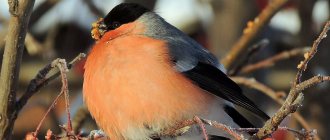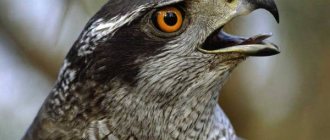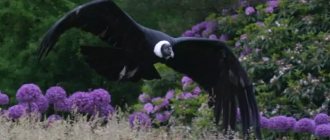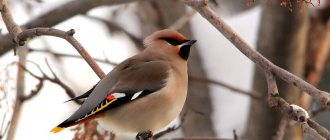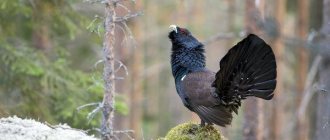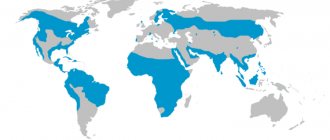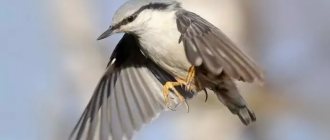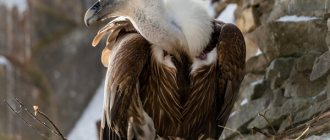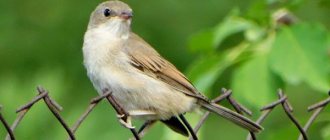- Wild animals
- >>
- Birds
The guillemot is the largest bird of the auk family. She took this place of honor after the extinction of the species of great loons. This is a large genus, which numbers more than 3 million pairs in Russia alone. This is a seabird, its life is spent near drifting ice and steep cliffs. During the breeding season, bird colonies reach several tens of thousands of birds. You can learn many interesting facts about guillemot here.
Origin of the species and description
Photo: Kaira
The genus Uria was defined by the French zoologist M. Brisson in 1760, establishing the slender-billed guillemot (Uria aalge) as the nominal species. Guillemots are related to the great auk (Alca torda), little auk (Alle alle) and the extinct great auk, and together they form the auk family (Alcidae). Despite the initial identification, according to DNA studies they are not as closely related to Cepphus grylle as previously thought.
Interesting fact: The genus name comes from the ancient Greek uria, a waterfowl mentioned by Athenaeus.
The genus Uria contains two species: the thin-billed guillemot (U. aalge) and the thick-billed guillemot (U. lomvia)
Some prehistoric species of Uria are also known:
- uria bordkorbi, 1981, Howard - Monterey, Late Miocene Lompoc, USA;
- uria affinis, 1872, Marsh - Late Pleistocene in the USA;
- uria paleohesperis, 1982, Howard - Late Miocene, USA;
- uria onoi Watanabe, 2016, Matsuoka and Hasegawa - Middle-Late Pleistocene, Japan.
U. brodkorbi is interesting because it is the only known auk member found in the temperate and subtropical Pacific Ocean, with the exception of the very edge of the range of U. aalge. This suggests that Uria species, which are the sister taxon to all other auks and are thought to have evolved in the Atlantic like them, may have evolved in the Caribbean or close to the Isthmus of Panama. The modern Pacific distribution would then be part of the later Arctic expansion, while most other lineages form clades with a continuous range in the Pacific from arctic to subtropical waters.
Habitat of the northern resident
As noted, guillemots need northern seas and oceans, which contain a lot of fish. The bird feels great even at the most extremely low temperatures. However, for normal life, the guillemot needs food and non-freezing water. The harsher the winter in the north, the closer to the south the guillemot moves for the winter. The guillemot's habitat extends from the shores of the North Atlantic to the North Pacific Ocean and the coast of the Arctic Ocean. To the south, the bird settles as far as Portugal, the British Isles, the Korean Peninsula, as well as the northern part of Japan and California. Thick-billed guillemots prefer Arctic waters.
Appearance and features
Photo: Guillemot bird
Guillemots are robust seabirds with black feathers covering their head, back and wings. White feathers cover their chest and lower parts of the body and wings. Both types of guillemots range in size from 39 to 49 cm and weigh somewhere between 1-1.5 kg. After the extinction of the great auk (P. impennis), these birds became the largest representatives of the auks. Their wingspan is 61 - 73 cm.
Video: Kaira
In winter, their neck and face turn pale gray. Their spear-shaped beak is gray and black with a white line running along the sides of the upper jaw. Long-billed guillemots (U. lomvia) can be distinguished from slender-billed guillemots (U. aalge) by their relatively robust features, which include a heavier head and neck and a short, stout bill. They also have more black plumage and lack most of the brown stripes on their sides.
Interesting fact: Species sometimes hybridize with each other, perhaps more often than previously thought.
Guillemots are diving birds with webbed feet and short legs and wings. Because their legs are set far back, they have a distinct upright posture, much like that of a penguin. Male and female guillemots look the same. Fledged chicks are similar to adults in terms of plumage, but have a smaller, thinner bill. They have a small, rounded black tail. The lower part of the face turns white in winter. The flight is strong and direct. Due to their short wings, their strikes are very fast. The birds make many harsh, giggling sounds in breeding colonies, but are silent at sea.
Ipatka
6. Hypata - Fratercula corniculata Naum.
B. Somewhat larger than a pigeon. OP. Similar to the puffin, but larger. The cheeks are white, the beak is yellow at the base. The leathery growth under the eye looks like a column. In winter, the beak is smaller, dark at the base, and there is no blade under the eye. Active during the day, sits on land, leaning on the tarsus of its paws. G. Silent “orr... orr...”. The voice is rarely heard. From. It differs from the puffin by its white belly and the absence of tufts of long feathers on the sides of its head. They are not found together with the puffin in nature. B. Rocky sea coasts and islands. HP. Sedentary and nomadic bird. Mr. It nests in small colonies on steep rocky shores. Nest in a rock crevice lined with dry grass. The clutch contains 1 white egg with vague gray-violet speckles.
Where does the guillemot live?
Photo: Kaira in Russia
Guillemot completely inhabits the Arctic and subarctic waters of the Northern Hemisphere. This migratory waterbird has a wide geographical distribution. In summer, it settles on the rocky coasts of Alaska, Newfoundland, Labrador, Sakhalin, Greenland, Scandinavia, the Kuril Islands in Russia, and Kodiak Island off the southern coast of Alaska. In winter, guillemots are found near open water, usually remaining along the edge of the ice zone.
Guillemots live in the coastal waters of the following countries:
- Japan;
- Eastern Russia;
- USA;
- Canada;
- Greenland;
- Iceland;
- Northern Ireland;
- England;
- Southern Norway.
Winter habitats range from the edge of open ice south to Nova Scotia and northern British Columbia, and are also found off Greenland, northern Europe, the Mid-Atlantic, the Pacific Northwest of the United States, and south in the Pacific to central Japan. After strong storms, some individuals may fly further south. This species occurs in large schools in the open ocean during the winter, but some vagrants may appear in bays, estuaries, or other bodies of water.
They typically hunt far from shore and are excellent divers, reaching depths of over 100 meters in pursuit of prey. The bird can also fly at a speed of 75 miles per hour, although it swims much better than it flies. Guillemots also form large aggregations on rocky shores, where females typically lay their eggs on a narrow ledge along a steep sea cliff. Less commonly, this occurs in caves and crevices. The species prefers to settle on islands rather than on mainland coasts.
Now you know where the murre bird lives. Let's see what she eats.
General information
The guillemot looks bright and noticeable, so it is easy to recognize among other birds. The black and white color stands out well. In winter the neck is white, and by summer it begins to turn black. The bird's beak is very strong, thick, sharp and curved down. It is always black with a thin border at the base. The body is wide at the top and tapers downwards, the tail is rounded and raised.
There are two types of guillemots: thick-billed and thin-billed. They are very similar in appearance, but they have several important differences. Distinctive features of the slender-billed guillemot:
- short neck;
- there are no gray speckles on the sides;
- dark parts of the color are more saturated;
- the beak is thinner and longer.
Females are slightly smaller than males, but otherwise they are similar. Ornithologists made an interesting observation: the species did not interbreed. Experts have also identified five subspecies of guillemots. Each of them has a different nesting site. For example, the California slender-billed guillemot prefers to live on the west coast of North America.
Birds can be found in the Arctic region, Sakhalin, North Korea, Great Britain and other territories. They choose hard-to-reach places to live. They like rocky places where few people can be found. Birds live well among such deserts .
The main habitat of guillemots is not only the Arctic regions. Nesting occurs on the rocks of the polar coasts and islands of the Pacific, Arctic and Atlantic oceans. In autumn, birds fly to the edge of solid ice.
During a harsh winter, the guillemot can fly inland. During migration, small drifting flocks of birds can be seen in open water.
Today the population of the species is not endangered and numbers more than a million individuals. The thick-billed guillemot is part of the polar ecosystem and is therefore protected in some countries.
What does guillemot eat?
Photo: Seabird guillemot
The predatory behavior of guillemots varies depending on the type of prey and habitat. They usually return to the colony with one prey item, except when capturing invertebrates. As generalist marine predators, guillemots' prey-capturing strategies are based on the potential energy gain from the prey item as well as the energy expenditure required to capture the prey.
Guillemots are carnivorous birds and consume a variety of marine life, including:
- pollock;
- bulls;
- flounder;
- capelin;
- gerbils;
- squid;
- cod;
- annelids;
- crustaceans;
- large zooplankton.
Guillemots feed underwater at depths of more than 100 meters, in waters with temperatures less than 8 °C. Slender-billed guillemots are skilled killers; they capture prey in active pursuit. On the other hand, thick-billed members of the genus spend more time hunting, but less energy searching for bottom prey, slowly sliding along the bottom in search of sediments or stones.
Additionally, based on its location, U. lomvia may also have location-related dietary differences. At the sea edge of the ice they feed in the water column and in the lower part of the fast ice. In contrast, at the edges of the ice sheet, U. lomvia feeds below the ice surface, on the seafloor, and in the water column.
Nutrition
The guillemot bird feeds on seafood. She loves to eat shrimp, crabs, capelin, gerbil, cod, and sea worms. In order to live and develop normally, a bird needs about 300 g of food per day.
The feces of these birds contain a huge amount of useful substances. Many sea mollusks happily feed on them, which then eventually become food for guillemots.
Features of character and lifestyle
Photo: Guillemots
Guillemots form large, dense aggregations in colonies on rock ledges where breeding occurs. Because of their clumsy take-off, the birds are considered more skilled swimmers than fliers. Adult and fledged chicks move long distances on migratory journeys from breeding colonies to places of maturation and wintering. The chicks swim almost 1,000 kilometers, accompanied by their male parents, on the first leg of their journey to their wintering grounds. During this time, adults moult into their winter plumage and temporarily lose the ability to fly until new feathers emerge.
Fun fact: Guillemots are usually active during the day. Using bird data loggers, scientists found that they travel from 10 to 168 km one way to feeding grounds.
These seabirds also play a significant role in marine ecosystems based on their pelagic diet. It is believed that guillemots communicate using sounds. In chicks, these are mainly abrupt sounds, characterized by a high-speed frequency-modulated outgoing call. This call is given when they leave the colony, and also as a way of communication between the chicks and their parents.
Adults, on the other hand, produce lower notes and sound rougher. These sounds are heavy, reminiscent of a "ha-ha-ha" laugh or a longer, growling sound. When aggressive, guillemots emit weak, rhythmic vocalizations. Despite the fact that species can live together, in general, guillemots are quite scandalous and quarrelsome birds. They get along only with larger arctic inhabitants, for example, great cormorants. This helps guillemots when attacking predators.
Option No. 2
The northern polar region of our planet is of extraordinary interest in several fields of science such as geography, biology, and history. This is due to the fact that it has features associated with its geographical location, the uniqueness of the plant and animal worlds, and climate.
Due to the presence of permafrost, the topography of this area is also unusual. Some part is represented by mountainous terrain, the other has ice cover, which occupies the main part of the Arctic. However, the Arctic desert zone, represented by a rocky surface, also sometimes pleases the eyes of residents.
The world of Arctic fauna has its own characteristics. The species diversity of living creatures inhabiting the Arctic is poor. However, their number is large.
The group of Arctic predators is represented by the wolf, wolverine, polar bear, and scribe. Reindeer and musk ox are common among herbivores.
Despite the great remoteness of the Arctic, people sometimes treat them thoughtlessly, subjecting them to extinction for life. Therefore, some animals of the Arctic zone today occupy positions in the Red Book (Atlantic walrus, polar bear, musk ox).
The population of the Arctic is represented by the Inuit and Eskimos, who, due to cold climatic conditions, have their own unique methods of obtaining food and their own customary methods of building dwellings. The indigenous people of this area have their own traditions and culture. The Chukchi and Nenets developed the territory of Northern Eurasia.
Social structure and reproduction
Photo: Pair of guillemots
Guillemots begin breeding at five to six years of age and nest in large, dense, noisy colonies on narrow rock ledges. Within their colony, the birds stand side by side, forming dense nesting habitat to protect themselves and their young from aerial predators. Typically arrive at breeding sites in the spring, from April to May, but since the ledges are often still covered with snow, egg laying begins in late May or early June, depending on sea temperature.
Females lay their eggs at approximately the same time to synchronize the timing of hatching and the moment when the juveniles jump from the nesting ledges into the sea to carry out their long migration for the winter. Female guillemots lay a single egg with a thick and heavy shell, greenish to pinkish in color, with patterned spots.
Interesting fact: The guillemot's eggs are pear-shaped, so it does not roll in a straight line when pushed, which prevents it from being accidentally pushed off a high ledge.
The females do not build the nest, but rather place pebbles around it along with other debris, holding the egg in place with the feces. Both the male and female take turns incubating the egg over a 33-day period. The chick hatches after 30–35 days, and both parents care for the chick until it jumps off the cliffs at 21 days of age.
Both parents incubate the egg continuously, taking shifts of 12 to 24 hours. The chicks feed mainly on fish brought by both parents to the breeding site for 15-30 days. Chicks usually fledge at around 21 days of age. After this moment, the female goes to sea. The male parent remains to care for the chick for a longer period of time, after which he goes to sea with the chick at night in calm weather. Males spend 4 to 8 weeks with their offspring before they achieve full independence.
Unique egg shape
The egg has an oval pear shape. When the animal takes off, the egg spins from the flapping of its wings, spins on the edge, but does not fall. It spins in a small place in a circle and returns to its place. An amazing way of brooding for birds that live on sharp, narrow rock ledges. After rotation, the oblong egg falls into the nearest small depression; when mom returns, she will roll it deeper to a safer place.
Natural enemies of murres
Photo: Guillemot bird
Guillemots are mainly vulnerable to aerial predators. Gray gulls are known to prey on eggs and chicks left unattended. However, a dense nesting colony of guillemots, in which the birds stand grouped side by side, helps protect adults and their young from air raids by eagles, gulls, and other predatory birds, as well as from ground attack by arctic foxes. In addition, people, including groups in Canada and Alaska, hunt and consume muthi eggs as food.
The most famous predators of saury include:
- glaucous glaucous (L. hyperboreus);
- Accipitridae (Accipitridae);
- common crows (Corvus corax);
- arctic fox (Vulpes lagopus);
- people (Homo Sapiens).
In the Arctic, people often hunt guillemots as a food source. Natives of Canada and Alaska shoot the birds annually near their breeding colonies or during their migration from the Greenland coast as part of traditional food hunting. Additionally, some groups, such as the Alaskans, collect eggs for food. In the 1990s, the average household on St. Lawrence Island (located west of mainland Alaska in the Bering Sea) consumed between 60 and 104 eggs per year.
The average lifespan of guillemots in the wild can reach 25 years. In northeastern Canada, the annual adult survival rate was estimated at 91%, and for those aged three years and older, it was 52%. Guillemots are vulnerable to man-made threats such as oil spills and nets.
Abstract of NOD "Arctic"
Irina Lokteva
Abstract of NOD "Arctic"
Summary of direct educational activities.
Educational field: "Cognitive development"
Introduce children to the Far North.
Tasks.
Educational:
introduce children to the climatic conditions of the Arctic; with such phenomena as polar night and day, northern lights. To form an idea of the flora and fauna, their characteristics and adaptations to the conditions of the Far North. Enrich children's vocabulary with words: Arctic, polar night, polar day, polar bear, walrus, seal, guillemots, loons, puffins.
Improve your ability to draw landscapes of the Far North.
Educational:
develop curiosity, imagination, creativity.
Educational:
to cultivate a love for the nature of Russia, an interest in research activities and a desire to study nature.
Integrated educational areas:
“Cognitive development”, “Artistic and aesthetic development”, “Social and communicative development”.
Activities:
gaming, communicative, cognitive-research, motor.
Planned results:
has an idea of Arctic animals, identifies them by appearance, knows their names; knows the peculiarities of the climate and the composition of the flora of the Arctic, independently draws such a natural phenomenon as the northern lights.
Materials:
paintings depicting the Arctic, polar night, northern lights, animals: polar bear, seal, walrus; plants: mosses, lichens; birds: guillemots, loons, puffins; traces of animals: bear, seal, birds; audio recording of a blizzard and a calm classical melody.
For experience:
a bowl of water, rich cream, towels.
